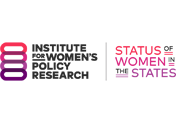
Poverty & Opportunity
Women’s status in the area of poverty and opportunity in the United States has improved on two indicators since the publication of IWPR’s 2004 Status of Women in the States report and declined on two others. The share of women with a bachelor’s degree or higher increased 6.9 percentage points during this time period, from 22.8 to 29.7 percent, and the share of women-owned businesses increased from 26.0 to 28.8 percent. The percent of women living above poverty, however, declined from 87.9 in 2002 to 85.4 in 2013 (IWPR 2004; U.S. Department of Commerce 2014a). The percent of women with health insurance in 2013 (81.5) was also slightly lower than in 2002 (82.3 percent), but the 2013 data do not reflect shifts in coverage following the passage of the Patient Protection and Affordable Care Act (ACA) of 2010.
View All State Rankings See Key Indicators| Best | Worst |
|---|---|
| 1. Maryland | 51. Mississippi |
| 2. District of Columbia | 50. Louisiana |
| 3. Massachusetts | 49. Kentucky |
| 4. Connecticut | 47. West Virginia |
| 5. Colorado | 47. Arkansas |




